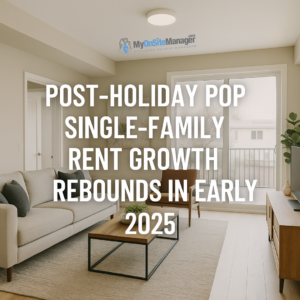After months of cooling, U.S. single-family rents are on the rise again—and this time, the growth is accelerating faster than expected for the winter season. According to CoreLogic’s January 2025 Single-Family Rent Index (SFRI), nationwide rent growth hit 2.4% year-over-year, up from 2.1% in December and marking a meaningful rebound from late-2024 lows.
With this uptick comes a mix of relief and renewed concern: while the pace of growth remains within historical norms, the sharper-than-usual monthly increase hints at increasing pressure for renters heading into peak leasing season.
Rent Growth Revs Up in January
Typically, rent growth slows during the winter months, especially in January when leasing activity is at a seasonal low. But this year defied expectations:
-
Year-over-Year Growth: U.S. single-family rents rose 2.4% in January 2025.
-
Monthly Spike: Rents increased 0.4% compared to December—quadruple the typical January month-over-month increase (0.1%).
-
Recovery Signs: While still under the January 2024 rate of 2.6%, the pace has turned upward again, suggesting the market may be exiting its late-2024 lull.
CoreLogic’s Principal Economist Molly Boesel noted, “The overall growth rate for single-family rents is returning to a more typical seasonal pattern after a four-year low in December.” This signals that the rental market may be finding its footing after the disruptive years that followed the pandemic.
Growth by Price Tier
The CoreLogic data reveals notable differences across price segments:
-
High-End Rentals (125%+ of regional median):
-
Grew by 3.2% YoY—a significant rebound from 2.5% last year.
-
Demand from well-off renters and investors may be fueling these gains.
-
-
Low-End Rentals (75% or less of regional median):
-
Slower growth at 1.9% YoY, down from 2.8% in January 2024.
-
This slower pace reflects persistent affordability challenges and constrained supply of entry-level rental housing.
-
Detached vs. Attached Homes
-
Detached single-family rentals: +2.3% YoY
-
Attached single-family rentals: +2.6% YoY
While both categories are growing at healthy rates, attached homes are slightly outpacing detached ones, likely due to a lower price point and denser urban location options.
Market-by-Market Highlights
Rental trends continue to diverge significantly by metro area:
Fastest-Growing Metros:
-
Washington, D.C.: +6.4% YoY (the nation’s highest)
-
Chicago: +6.0%
-
Boston: +4.4%
These cities are seeing a combination of population return, limited housing inventory, and revitalized demand—particularly in areas that cooled dramatically during the pandemic.
Slowest-Growing Metros:
-
Dallas: +0.3%
-
Miami: +1.4%
-
Atlanta: +1.5%
These Sun Belt metros, which saw explosive growth during 2020–2022, are now seeing a slowdown as supply catches up and renters face affordability ceilings.
Post-Pandemic Perspective
Since 2020, some of the largest rent increases in the country have occurred in:
-
Miami: +52%
-
Washington, D.C.: +30%
-
Chicago: +25%
While the pace of growth has slowed, the long-term increase in housing costs continues to impact affordability, especially in previously lower-cost areas that have since seen sharp rent inflation.
What’s Driving the Rebound?
Several forces are at play behind January’s unseasonal rent uptick:
-
Limited For-Sale Inventory
Homebuyers continue to face a challenging market marked by high mortgage rates and low inventory. This forces many would-be buyers to remain renters longer, driving demand. -
Stabilizing Job Markets
Steady employment in most metro areas has helped support renters’ ability to absorb slight rent increases. -
Seasonal Resurgence
January’s spike could reflect early leasing activity for spring and summer—a signal that more growth could be ahead. -
Stratified Affordability
The divergence between high-end and low-end rent growth underscores a continuing affordability divide. Higher-income renters remain relatively insulated, while lower-income households face limited options.
What to Watch in 2025
As we head deeper into 2025, the big question is whether this rebound will hold:
-
Will rent growth return to pre-pandemic norms of 3–4% annually?
-
Can supply keep up with demand, especially in affordable segments?
-
How will local market policies impact growth in hot metros like D.C. and Chicago?
With the spring and summer rental seasons approaching, all eyes are on whether this January bump is a temporary blip—or the beginning of a broader upward trend.
Final Thoughts
The U.S. single-family rental market appears to be entering a new chapter. Renters may see more increases in the coming months, especially in competitive and high-cost cities. For landlords and investors, this signals strengthening returns—though affordability pressures are likely to keep regulatory and social attention on the market throughout the year.
Source: World Property Journal – “Single‑Family Rent Growth in U.S. Trends Upward in 2025”

